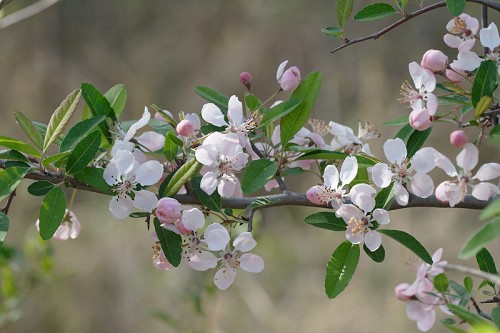Difference between revisions of "Malus angustifolia"
(→Ecology) |
(→Conservation and Management) |
||
| Line 44: | Line 44: | ||
==Conservation and Management== | ==Conservation and Management== | ||
| + | Florida has classified ''M. angustifolia'' as threatened; it is endangered in Illinois, and of special concern in Kentucky. <ref name= "USDA"> [https://plants.usda.gov/core/profile?symbol=CEAM USDA Plant Database]</ref> | ||
==Cultivation and restoration== | ==Cultivation and restoration== | ||
Revision as of 15:17, 24 May 2018
| Malus angustifolia | |
|---|---|

| |
| Photo by the Southeastern Flora Database | |
| Scientific classification | |
| Kingdom: | Plantae |
| Division: | Magnoliophyta - Flowering plants |
| Class: | Magnoliopsida - Dicots |
| Order: | Rosales |
| Family: | Rosaceae |
| Genus: | Malus |
| Species: | M. angustifolia |
| Binomial name | |
| Malus angustifolia Michx. | |

| |
| Natural range of Malus angustifolia from USDA NRCS Plants Database. | |
Contents
Taxonomic Notes
Synonym: Pyrus angustifolia (Aiton), Pyrus angustifolia var. spinosa (Rehder) L.H. Bailey
Variety: none
Description
M. angustifolia is a perennial shrub/tree of the Rosaceae family that is native to North America.[1]
Distribution
M. angustifolia is found throughout the southeastern United States; specifically in Florida, Georgia, Alabama, South Carolina, North Carolina, Virginia, Maryland, Pennsylvania, New Jersey, Deleware, West Virginia, Ohio, Kentucky, Tennessee, Arkansas, Mississippi, Louisiana, and Texas.[1]
Ecology
Habitat
Ideal habitats for the M. angustifolia is in well drained but moist soils in valleys and other slopes, stream beds, borders of woodlands, old fields in the southeast, and even fence rows. It requires full sun for successful fruit and flowers. [1]
Use by animals
Whitetail deer will eat the fruit of the tree, as well as, bobwhites, grouse, pheasants, rabbits, squirrels, opposums, raccoons, skunks, foxes, and other small birds. [1]
Diseases and parasites
M angustifolia is prone to fireblight, cedar apple rust, apple scab, canker, scale, borers, and aphids. [1]
Conservation and Management
Florida has classified M. angustifolia as threatened; it is endangered in Illinois, and of special concern in Kentucky. [1]